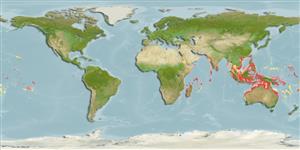Issue
Liza ordensis from northern Austalia is a different species on the basis of genetic results (Refs. 90274, 123265).
Environment: milieu / climate zone / depth range / distribution range
Ökologie
seewasser; süßwasser; brackwasser benthopelagisch; katadrom (Ref. 46888). Tropical; 23°N - 33°S, 25°E - 136°W
Indo-West Pacific: East Africa south to Algoa Bay, South Africa (Ref. 4393); Madagascar, northern Australia (Timor Sea), New Guinea and Tonga (Ref. 9812). Also reported from the Marquesas (Ref. 12792) and from the lower Zambezi River in Africa (Ref. 39494).
Size / Gewicht / Alter
Maturity: Lm ? range ? - ? cm
Max length : 75.0 cm TL Männchen/unbestimmt; (Ref. 9812); common length : 35.0 cm TL Männchen/unbestimmt; (Ref. 9812)
Rückenflossenstacheln (insgesamt) : 5; Rückenflossenweichstrahlen (insgesamt) : 8; Afterflossenstacheln: 3; Afterflossenweichstrahlen: 9.
Adults inhabit coastal waters, estuaries; sometimes ascending rivers into fresh water (Ref. 9812). They prefer slow moving waters or still lagoons (Ref. 9812). Often found in turbid water, over muddy substrates, and with well-substantiated aquatic vegetation (Ref. 9812). They feed on microalgae, detritus, terrestrial plant material, and aquatic insects (Ref. 9812). Perhaps catadromous (Ref. 9812). Oviparous, eggs are pelagic and non-adhesive (Ref. 205).
Life cycle and mating behavior
Maturities | Fortpflanzung | Spawnings | Egg(s) | Fecundities | Larven
Harrison, I.J. and H. Senou, 1997. Order Mugiliformes. Mugilidae. Mullets. p. 2069-2108. In K.E. Carpenter and V.H. Niem (eds.) FAO species identification guide for fishery purposes. The living marine resources of the Western Central Pacific. Volume 4. Bony fishes part 2 (Mugilidae to Carangidae). FAO, Rome. (Ref. 9812)
IUCN Rote Liste Status (Ref. 130435)
Bedrohung für Menschen
Harmless
Nutzung durch Menschen
Fischereien: weniger kommerziell; Sportfisch: ja
Tools
Zusatzinformationen
Download XML
Internet Quellen
Estimates based on models
Preferred temperature (Ref.
123201): 24.7 - 28.9, mean 27.7 °C (based on 808 cells).
Phylogenetic diversity index (Ref.
82804): PD
50 = 0.5078 [Uniqueness, from 0.5 = low to 2.0 = high].
Bayesian length-weight: a=0.01318 (0.00813 - 0.02137), b=2.92 (2.79 - 3.05), in cm total length, based on LWR estimates for this species & Genus-body shape (Ref.
93245).
Trophic level (Ref.
69278): 2.3 ±0.16 se; based on food items.
Widerstandsfähigkeit (Ref.
120179): niedrig, Verdopplung der Population dauert 4,5 - 14 Jahre. (Preliminary K or Fecundity.).
Fishing Vulnerability (Ref.
59153): Moderate to high vulnerability (50 of 100).
